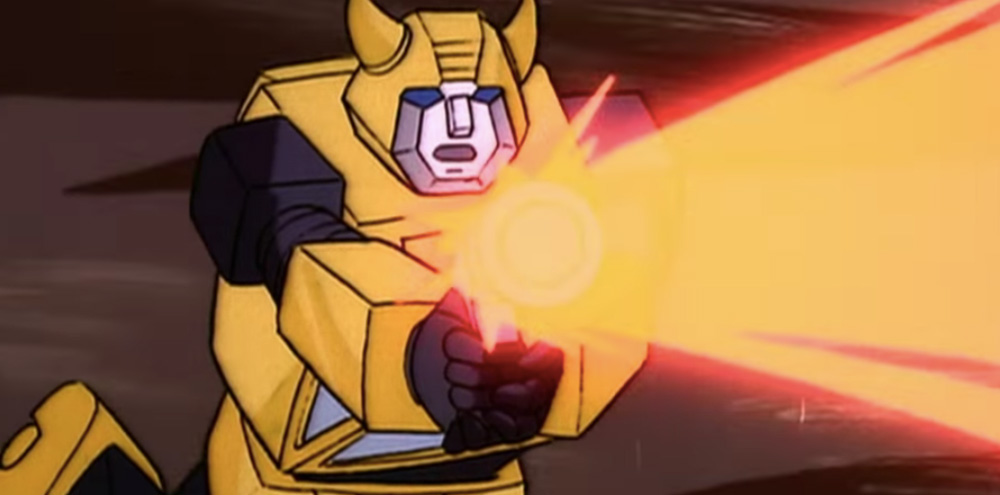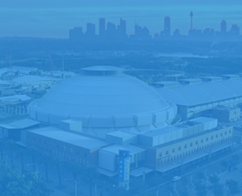
Sydney
June 21-22, 2025
Sydney Showground Olympic Park

Travis Knight’s Bumblebee is right around the corner, so what better time to revisit the Robots in Disguise and see what more there is than meets the eye.
The animated series that kicked off the franchise, and is often known by the fans as Generation 1. It begins with the core concept we now know so well, a civil war between the heroic Autobots and the villainous Decepticons for control over their home planet of Cybertron. The two factions wage war among the stars, before both ships suffer critical damage and crash land on Earth, in prehistoric times. They lay dormant for millions of years, before being awoken in 1985, so that their battle may begin again.
This series laid the groundwork for everything we love about the Transformers that came after, but as a product of its time, it doesn’t always hold up. Watching it in 2018, it’s more like a Vine compilation fever dream, with hilariously dated dialogue and animation errors, but it all adds a certain charm to it. The Decepticons would also receive much stronger characterisation in later reboots, as they’re somewhat one-dimensional villains here. Still, this show won its fans for a reason. The Autobots standing up for the humans even when the humans wouldn’t stand for them, and protecting the people that couldn’t protect themselves, are what makes Optimus and his Autobots such enduring characters, and are themes that get explored in pretty much every incarnation after.
Generation 1 is still the most explored part of the canon, with content still being produced for it, like the IDW comics currently running, and a game from PlatinumGames (the makers of Bayonetta and Nier: Automata) that isn’t just excellent supplementary material that cranks the feels up, it’s also a really fun game. The new film Bumblebee is heavily inspired by the 1984 show, especially with those old-school character designs and setting, so catching up on at least some of this is probably a good idea.
Set in the same continuity as the original show, this film is called back to non-stop, and that trend isn’t going away in Bumblebee, which features some shot-for-shot homages to this classic film. SPOILER ALERT, this film gave us the classic twist, which has now been done to Cybertron and back, of Prime dying, and traumatising an entire generation of children. It gave us Galvatron, played by Leonard Nimoy, who’ll come back later in this very article, and the world-eater Unicron, played by Orson Welles in his final role. A lot of the modern Transformers mythos have this film to thank for it. Oh, and we can’t forget the legendary song that is The Touch by Stan Bush. They even used it to introduce the actors at the Bumblebee San Diego Comic-Con panel. Travis Knight really likes this film, if you couldn’t tell.
Beast Wars and its follow-up Beast Machines are something of odd ducks in the franchise, but they certainly have their diehard fans, mainly for the comedic value and character designs. Megatron as a T-Rex is undeniably cool, we don’t care who you are. So this series is a little different, in that it follows the Maximals and Predacons, factions in a Cybertronian civil war, led by Optimus Primal and Megatron respectively, and follows them as they crash on a primitive alien planet. These Transformers actually landed sometime during the original G1 Transformers’ four million year sleep after they crash-landed on Earth. Yeah, so they’re set in the same universe. Boom. The twists just keep on piling from there but we don’t wanna spoil it for y’all. Sufficed to say, the goofy plot and dialogue are part of the reasons this show has its fanbase. This is the first Transformers show entirely in CG though, and uh, well, it’s not a look for everyone… (Also this series was called Beasties: Transformers in Canada, which is undeniably funny.)
Known by fans as the Unicron Trilogy, this is actually three different TV shows that aired from 2002 to 2006, known as Transformers: Armada, Transformers: Energon, and Transformers: Cybertron. These shows are not in the same universe as G1 and Beast Wars, so they’re not required material for Bumblebee, but they’re still worth watching for you completionists.
In Armada, the Autobots and Decepticons, still waging that old civil war, are now fighting over a race of teeny tiny Transformers called Mini-Cons, who power up the Cybertronian using them. Naturally, the Mini-Cons attempt to flee the conflict, but they’re attacked, and no guesses on which planet they crash land on (but if you guessed Earth you’d be correct).
Energon continues where Armada left off, which makes it hard to explain without spoiling Armada, and also just because it’s quite ambitious for a kids show, with people getting resurrected left, right, and centre, then stealing other people’s bodies, and yeah, we won’t even try.
Cybertron is way easier, because it literally has nothing to do with the first two, despite being advertised as a sequel! A slight miscommunication between Japan and America led to this accident, which meant dialogue had to be thrown into Cybertron to connect it to the previous two series. This time, a black hole has opened that threatens to swallow Cybertron whole, and the only solution is for the Autobots to go to Earth and find the Cyber Planet Maguffins Keys. It does add a few new elements to the lore, such as Primus, the deity of the Cybertronians, but overall, Cybertron is really only notable for its theme song. Early 2000s kids will know, this theme slaps.
This unique take on the series has become something of a cult classic among Transformers fans, and it’s not hard to see why. It reimagines Optimus as a young, inexperienced leader, looking to prove himself. Instead of a warrior, he’s captain of a humble salvage ship, years after the Autobots have already won the civil war against the Decepticons. When Optimus’ crew comes across the legendary Allspark though, Megatron wants it for himself, naturally. They fight, and… some things never change, as they crash land on Earth. Again. And again. And again. They lie in stasis for 50 years, and a brilliant scientist uses Megatron’s dormant body to advance technology decades ahead of its time.
You can probably tell that this borrows some elements from Michael Bay’s first Transformers film, but it does way more differently than it does the same as previous incarnations. Optimus finally being a lower-status character is a nice change to the status quo, and when bigger, badder Autobots like Sentinel Prime and Ultra Magnus show up, Optimus gets to show what he’s made of. The new cast of Autobots also features some cool new additions, like the ninja Prowl, and the clumsy Bulkhead. The art style also won many fans, as the simplified looks that still pay homage to G1 are different to anything fans have seen before. Animated won a niche fan base with its unique take on the franchise, and like all things that fans love, a fourth season was in development and abruptly cancelled.
Prime serves as a fairly dark interpretation for a kids show, with a consistently high body count. It was written by the duo who worked on the first two Michael Bay films, as they wanted to expand on the Transformers’ characterisation more, and flesh them out in ways a movie wouldn’t allow. To that end, it dives much deeper into characters like Megatron, and lets us see what really makes him tick, and what makes him so evil… It features familiar staples like Unicron, the Matrix, etc. but like we said, the strength is in the characters. When Optimus Prime loses his memory, he reverts back to a more warlike personality, named Orion Pax. Additions like this are what makes Prime stand out.
Robots in Disguise is only loosely connected to Prime, and has a much more kid-friendly tone. It does feature the Mini-Cons, though! Remember those? There will be a test on this. Despite the shows carrying over their visual style from the live-action films, the inclusion of the Fallen and Mini-Cons, and Bumblebee still having no voice, it has no relation to any other timeline, but it does tie-in to the two very popular games, War for Cybertron, and Fall of Cybertron.
The contentious one, we all know it. Some people love it. We’ll leave it there. This version of the series basically takes the idea back to its core roots from the ’80s cartoon. Optimus and the Autobots are in the midst of a civil war, they come to Earth, they don’t understand human culture, and they’re helped by human children to make sense of the new world they find themselves on. Sam Witwicky even has the last name as Danny, the original boy human who helped them in the ’80s show.
However, this version is also directly influenced by Michael Bay’s auteurial vision. The Autobots are far more aggressive in this version, to reflect Bay’s fascination with the military and war. The core of the characters is still there, such as Optimus’ desire to protect innocent life, but he’s also far more willing to toe the line between good and evil to achieve his peace. A huge part of the canon that has made its way into the new cartoons now, is Bumblebee’s lack of a voice, which was destroyed in battle.
The films call back to the original show in a lot of ways, with Unicron, Sentinel Prime (played by Leonard Nimoy!), the Matrix of Leadership, the Witwicky family, even down to certain lines of dialogue, but some new lore additions also exist. Quintessa and The Fallen are the two big additions, Cybertronians more ancient than the Autobots or Decepticons, with hands in the Transformers’ history. We haven’t seen them expanded upon yet, and with a sixth film unlikely to happen, we may never learn more about them in the films. But y’all didn’t come here for lore.
We know why people watch these movies. Bayhem. It could certainly be argued that these films are more “Michael Bay” films than “Transformers” films, but there is plenty of good TF juice on these bones, particularly in the characterisation of Optimus and Bumblebee, who definitely receive more love than any other Transformers over the five films.
So that’s a heavily abridged beginner’s guide to the Transformers universe, a basic idea of what you should know before you see Bumblebee this December. With 34 years of content, looking at the sheer scope of the series is daunting, but there are really no wrong places to start, and whether you want comedy, drama, or action, there’s at least one part of the franchise sure to capture someone’s heart. Now transform and roll outta here already!
JAPANESE EXCLUSIVE SHOWS
Alright, let’s do a quick breeze through some of the stranger additions to the franchise. First up, Transformers: Headmasters, and it has nothing to do with school. Depending on what side of the world you live on, the Headmasters are either Cybertronians that merged with organic aliens (Western version), or a group of small Cybertronians who departed their planet millions of years ago and crash-landed on the inhospitable planet Master. To survive, they constructed larger bodies called “Transtectors”, to which they connected as the heads (Eastern version). It is technically set in the G1 universe, as the Japanese broadcasters simply declined to air the finale of the original show, and kept producing material to keep it going, which is a big mood if you’ve ever wanted a good show to just, not end. The show has only been dubbed “in English” once, and we use quotation marks because it was done in Hong Kong, and the translation leaves a lot to be desired, unless you’re just in it for the laughs. It gave us lines like “I’ll send you express to hell!” and changed some Transformers’ names. But like, not noticeable changes, really small ones. For example, Blaster is named… Billy, Blurr is named… Wally, Spike is… Sparkle. Subtle stuff. Also, they beat the villain with the power of friendship, for real.
Next, Beast Wars II: Super Life-Form Transformers. When there weren’t enough episodes in season two of the American Beast Wars to justify airing it on Japanese TV, they thought,“ You want something done right, do it yourself,” so they really just made their own season, complete with conventional animation instead of CG, and redesigns of the main characters. And their names got changed too, for some reason. Optimus Primal is now Lio Convoy, leader of the Cybertrons, and Megatron is Galvatron, leader of the Destrons, and they fight on the Planet Gaia (a post-apocalyptic Earth), for control of the energy source, Angolmois energy. It even got a movie, Beast Wars II: Lio Convoy’s Close Call! where Optimus Primal gets summoned from the ancient past.
To wrap up the Japan-only Beast Wars timeline is Super Life-Form Transformers: Beast Wars Neo, where the Cybertrons and Destrons must team up to stop Unicron and his minions, the Blentrons, nobody’s favourite name for a Transformer.
Finally, Transformers: Robots in Disguise (2001), and Transformers Go! are just two anime series, but they’re really anime. There are Samurai and Shinobi Autobots, and Optimus Prime and Ultra Magnus go full DBZ and fuse into Omega Prime.






